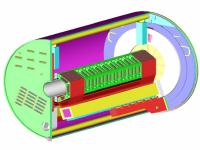
|

|

|

|
Notes about problems with MCM 107
MCM-107 was originally tested 9-Jul-99. It failed because "7/8 of the MCM does not respond to Vcal. -- double peaked ADC distribution (several 100 channels apart) for single Vcal value. Some suspicion it is a Xilinx problem. Check this one again." In addition to these problems, test-point 9 (which is connected to the Vfb DAC on TGV chip 1) showed no response to changes in the DAC -- although the serial readback said it was OK. In addition, the AMU spy channels (MUX2) did not work on any chip and the pre-amp spy channels worked only one of the many times we tried to turn them on. Because of the spy channel problems, the discriminator was not tested (we use the spy channels to trigger the scope in these tests).
The old tests were done with a xilinx program (mcm11.hex) which did not work perfectly. It was retested 5-Aug-99 with a new xilinx code which is believed to work correctly. Only the response to Vcal was retested. There was no significant change in the results. Only the first of 8 block of 32 channels responds correctly to Vcal. A fixed vaue of Vcal results in two or more (usually 2) completely different ADC values -- which usually differ by 100's of channels. I found that I could get 6 of 8 blocks of 32 channels (2,3,4,6,7,8) to work correctly by sending an MCM reset after every event. This test was done in raw (aka correlator off) mode using mcmr8.hex. The strangest part of this test was that I saw a clear pattern in which the ADC data looked "correct" in one event and "incorrect" in the next event. I saw this alternating pattern of good/bad events repeated at least 30 times. The events were always "good" if I sent an MCM reset prior to the event. When I switched back to correlator-on, I saw no obvious pattern -- the ADC values just jumped around eratically.
My conclusion is still that this MCM is not usuable because issuing an MCM reset prior to each event is not a practical running condition -- and that only made it work in raw mode, which is not our usual running condition. The fact that the voltage at test-point 9 did not seem to respond to the DAC (but the DAC seems to work) suggests that there is a connectivity problem in at least one place on this MCM.